Jiangrong Shen
Spiking Neural Networks with Temporal Attention-Guided Adaptive Fusion for imbalanced Multi-modal Learning
May 20, 2025Abstract:Multimodal spiking neural networks (SNNs) hold significant potential for energy-efficient sensory processing but face critical challenges in modality imbalance and temporal misalignment. Current approaches suffer from uncoordinated convergence speeds across modalities and static fusion mechanisms that ignore time-varying cross-modal interactions. We propose the temporal attention-guided adaptive fusion framework for multimodal SNNs with two synergistic innovations: 1) The Temporal Attention-guided Adaptive Fusion (TAAF) module that dynamically assigns importance scores to fused spiking features at each timestep, enabling hierarchical integration of temporally heterogeneous spike-based features; 2) The temporal adaptive balanced fusion loss that modulates learning rates per modality based on the above attention scores, preventing dominant modalities from monopolizing optimization. The proposed framework implements adaptive fusion, especially in the temporal dimension, and alleviates the modality imbalance during multimodal learning, mimicking cortical multisensory integration principles. Evaluations on CREMA-D, AVE, and EAD datasets demonstrate state-of-the-art performance (77.55\%, 70.65\% and 97.5\%accuracy, respectively) with energy efficiency. The system resolves temporal misalignment through learnable time-warping operations and faster modality convergence coordination than baseline SNNs. This work establishes a new paradigm for temporally coherent multimodal learning in neuromorphic systems, bridging the gap between biological sensory processing and efficient machine intelligence.
Self-cross Feature based Spiking Neural Networks for Efficient Few-shot Learning
May 15, 2025Abstract:Deep neural networks (DNNs) excel in computer vision tasks, especially, few-shot learning (FSL), which is increasingly important for generalizing from limited examples. However, DNNs are computationally expensive with scalability issues in real world. Spiking Neural Networks (SNNs), with their event-driven nature and low energy consumption, are particularly efficient in processing sparse and dynamic data, though they still encounter difficulties in capturing complex spatiotemporal features and performing accurate cross-class comparisons. To further enhance the performance and efficiency of SNNs in few-shot learning, we propose a few-shot learning framework based on SNNs, which combines a self-feature extractor module and a cross-feature contrastive module to refine feature representation and reduce power consumption. We apply the combination of temporal efficient training loss and InfoNCE loss to optimize the temporal dynamics of spike trains and enhance the discriminative power. Experimental results show that the proposed FSL-SNN significantly improves the classification performance on the neuromorphic dataset N-Omniglot, and also achieves competitive performance to ANNs on static datasets such as CUB and miniImageNet with low power consumption.
Hybrid Spiking Vision Transformer for Object Detection with Event Cameras
May 12, 2025Abstract:Event-based object detection has gained increasing attention due to its advantages such as high temporal resolution, wide dynamic range, and asynchronous address-event representation. Leveraging these advantages, Spiking Neural Networks (SNNs) have emerged as a promising approach, offering low energy consumption and rich spatiotemporal dynamics. To further enhance the performance of event-based object detection, this study proposes a novel hybrid spike vision Transformer (HsVT) model. The HsVT model integrates a spatial feature extraction module to capture local and global features, and a temporal feature extraction module to model time dependencies and long-term patterns in event sequences. This combination enables HsVT to capture spatiotemporal features, improving its capability to handle complex event-based object detection tasks. To support research in this area, we developed and publicly released The Fall Detection Dataset as a benchmark for event-based object detection tasks. This dataset, captured using an event-based camera, ensures facial privacy protection and reduces memory usage due to the event representation format. We evaluated the HsVT model on GEN1 and Fall Detection datasets across various model sizes. Experimental results demonstrate that HsVT achieves significant performance improvements in event detection with fewer parameters.
ALADE-SNN: Adaptive Logit Alignment in Dynamically Expandable Spiking Neural Networks for Class Incremental Learning
Dec 17, 2024



Abstract:Inspired by the human brain's ability to adapt to new tasks without erasing prior knowledge, we develop spiking neural networks (SNNs) with dynamic structures for Class Incremental Learning (CIL). Our comparative experiments reveal that limited datasets introduce biases in logits distributions among tasks. Fixed features from frozen past-task extractors can cause overfitting and hinder the learning of new tasks. To address these challenges, we propose the ALADE-SNN framework, which includes adaptive logit alignment for balanced feature representation and OtoN suppression to manage weights mapping frozen old features to new classes during training, releasing them during fine-tuning. This approach dynamically adjusts the network architecture based on analytical observations, improving feature extraction and balancing performance between new and old tasks. Experiment results show that ALADE-SNN achieves an average incremental accuracy of 75.42 on the CIFAR100-B0 benchmark over 10 incremental steps. ALADE-SNN not only matches the performance of DNN-based methods but also surpasses state-of-the-art SNN-based continual learning algorithms. This advancement enhances continual learning in neuromorphic computing, offering a brain-inspired, energy-efficient solution for real-time data processing.
Context Gating in Spiking Neural Networks: Achieving Lifelong Learning through Integration of Local and Global Plasticity
Jun 04, 2024Abstract:Humans learn multiple tasks in succession with minimal mutual interference, through the context gating mechanism in the prefrontal cortex (PFC). The brain-inspired models of spiking neural networks (SNN) have drawn massive attention for their energy efficiency and biological plausibility. To overcome catastrophic forgetting when learning multiple tasks in sequence, current SNN models for lifelong learning focus on memory reserving or regularization-based modification, while lacking SNN to replicate human experimental behavior. Inspired by biological context-dependent gating mechanisms found in PFC, we propose SNN with context gating trained by the local plasticity rule (CG-SNN) for lifelong learning. The iterative training between global and local plasticity for task units is designed to strengthen the connections between task neurons and hidden neurons and preserve the multi-task relevant information. The experiments show that the proposed model is effective in maintaining the past learning experience and has better task-selectivity than other methods during lifelong learning. Our results provide new insights that the CG-SNN model can extend context gating with good scalability on different SNN architectures with different spike-firing mechanisms. Thus, our models have good potential for parallel implementation on neuromorphic hardware and model human's behavior.
Towards Efficient Deep Spiking Neural Networks Construction with Spiking Activity based Pruning
Jun 03, 2024



Abstract:The emergence of deep and large-scale spiking neural networks (SNNs) exhibiting high performance across diverse complex datasets has led to a need for compressing network models due to the presence of a significant number of redundant structural units, aiming to more effectively leverage their low-power consumption and biological interpretability advantages. Currently, most model compression techniques for SNNs are based on unstructured pruning of individual connections, which requires specific hardware support. Hence, we propose a structured pruning approach based on the activity levels of convolutional kernels named Spiking Channel Activity-based (SCA) network pruning framework. Inspired by synaptic plasticity mechanisms, our method dynamically adjusts the network's structure by pruning and regenerating convolutional kernels during training, enhancing the model's adaptation to the current target task. While maintaining model performance, this approach refines the network architecture, ultimately reducing computational load and accelerating the inference process. This indicates that structured dynamic sparse learning methods can better facilitate the application of deep SNNs in low-power and high-efficiency scenarios.
Enhancing Adaptive History Reserving by Spiking Convolutional Block Attention Module in Recurrent Neural Networks
Jan 08, 2024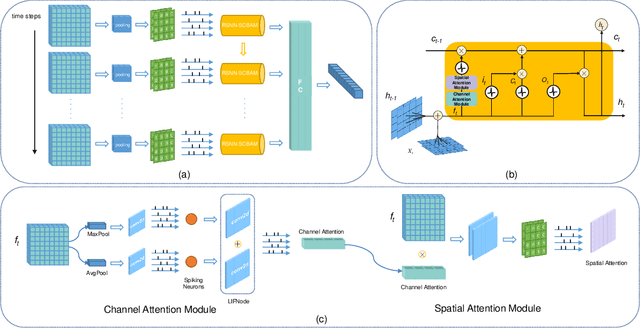
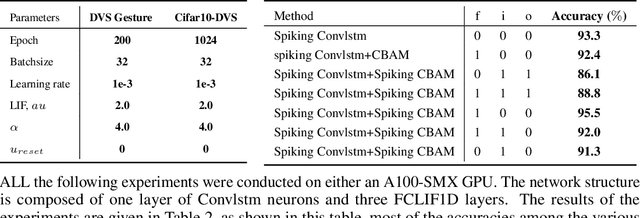
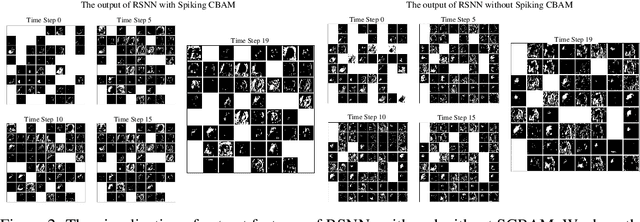
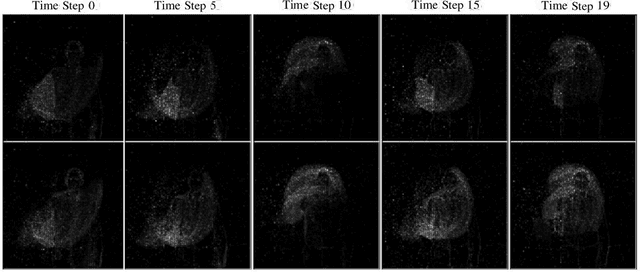
Abstract:Spiking neural networks (SNNs) serve as one type of efficient model to process spatio-temporal patterns in time series, such as the Address-Event Representation data collected from Dynamic Vision Sensor (DVS). Although convolutional SNNs have achieved remarkable performance on these AER datasets, benefiting from the predominant spatial feature extraction ability of convolutional structure, they ignore temporal features related to sequential time points. In this paper, we develop a recurrent spiking neural network (RSNN) model embedded with an advanced spiking convolutional block attention module (SCBAM) component to combine both spatial and temporal features of spatio-temporal patterns. It invokes the history information in spatial and temporal channels adaptively through SCBAM, which brings the advantages of efficient memory calling and history redundancy elimination. The performance of our model was evaluated in DVS128-Gesture dataset and other time-series datasets. The experimental results show that the proposed SRNN-SCBAM model makes better use of the history information in spatial and temporal dimensions with less memory space, and achieves higher accuracy compared to other models.
Neuromorphic Auditory Perception by Neural Spiketrum
Sep 11, 2023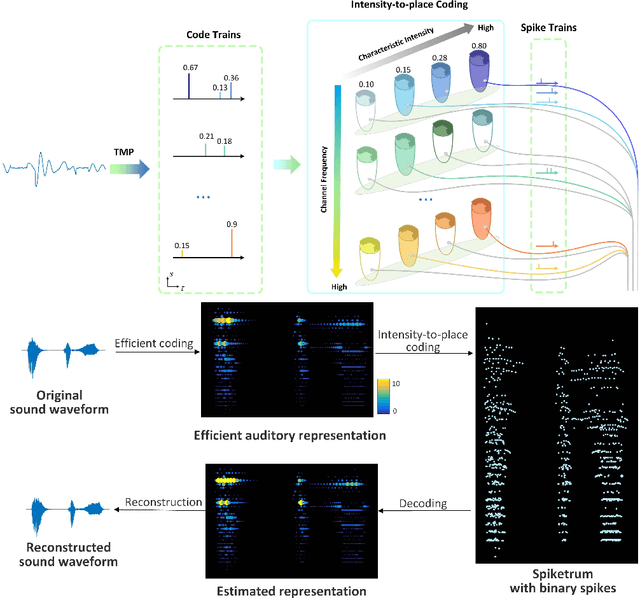
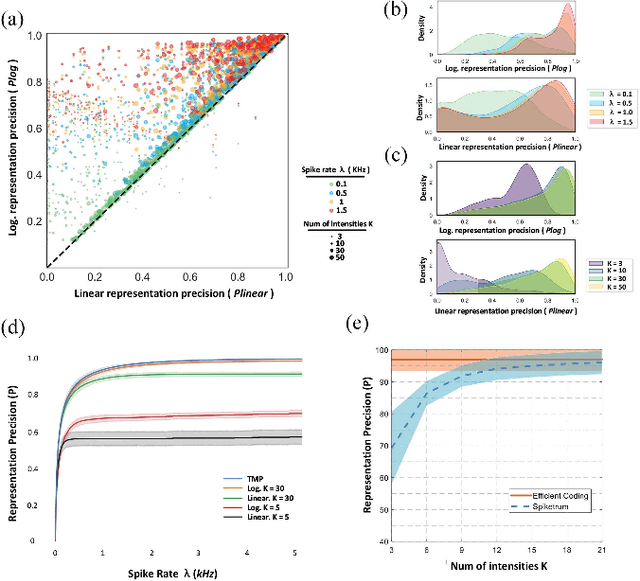
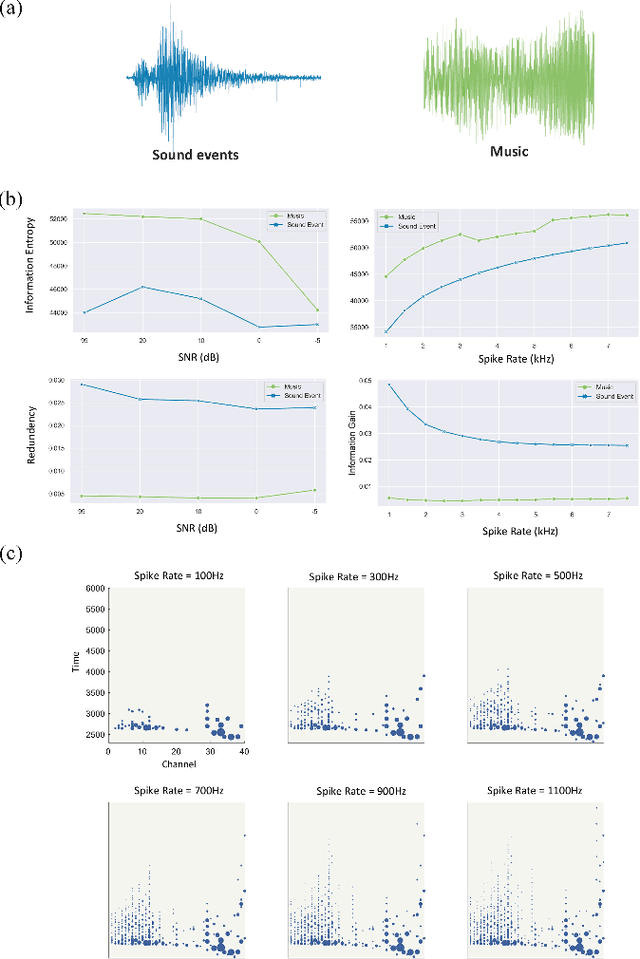
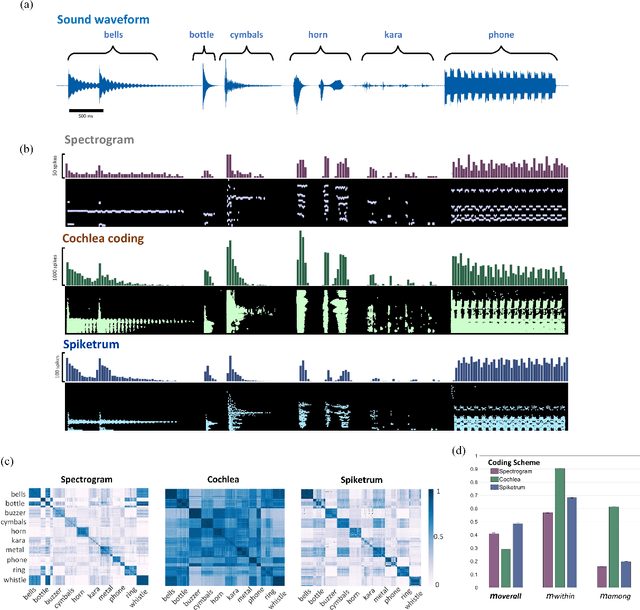
Abstract:Neuromorphic computing holds the promise to achieve the energy efficiency and robust learning performance of biological neural systems. To realize the promised brain-like intelligence, it needs to solve the challenges of the neuromorphic hardware architecture design of biological neural substrate and the hardware amicable algorithms with spike-based encoding and learning. Here we introduce a neural spike coding model termed spiketrum, to characterize and transform the time-varying analog signals, typically auditory signals, into computationally efficient spatiotemporal spike patterns. It minimizes the information loss occurring at the analog-to-spike transformation and possesses informational robustness to neural fluctuations and spike losses. The model provides a sparse and efficient coding scheme with precisely controllable spike rate that facilitates training of spiking neural networks in various auditory perception tasks. We further investigate the algorithm-hardware co-designs through a neuromorphic cochlear prototype which demonstrates that our approach can provide a systematic solution for spike-based artificial intelligence by fully exploiting its advantages with spike-based computation.
ESL-SNNs: An Evolutionary Structure Learning Strategy for Spiking Neural Networks
Jun 06, 2023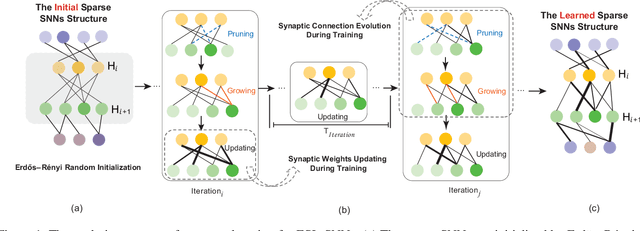

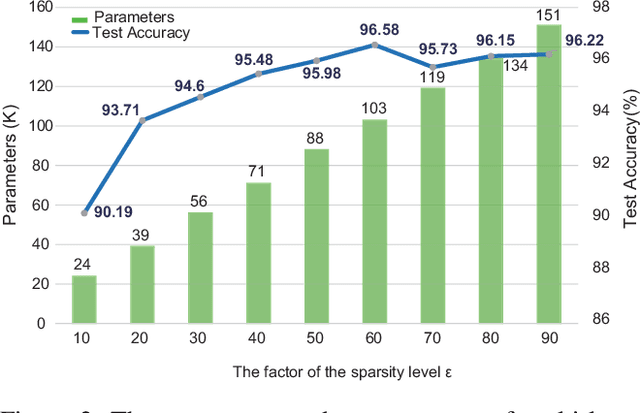

Abstract:Spiking neural networks (SNNs) have manifested remarkable advantages in power consumption and event-driven property during the inference process. To take full advantage of low power consumption and improve the efficiency of these models further, the pruning methods have been explored to find sparse SNNs without redundancy connections after training. However, parameter redundancy still hinders the efficiency of SNNs during training. In the human brain, the rewiring process of neural networks is highly dynamic, while synaptic connections maintain relatively sparse during brain development. Inspired by this, here we propose an efficient evolutionary structure learning (ESL) framework for SNNs, named ESL-SNNs, to implement the sparse SNN training from scratch. The pruning and regeneration of synaptic connections in SNNs evolve dynamically during learning, yet keep the structural sparsity at a certain level. As a result, the ESL-SNNs can search for optimal sparse connectivity by exploring all possible parameters across time. Our experiments show that the proposed ESL-SNNs framework is able to learn SNNs with sparse structures effectively while reducing the limited accuracy. The ESL-SNNs achieve merely 0.28% accuracy loss with 10% connection density on the DVS-Cifar10 dataset. Our work presents a brand-new approach for sparse training of SNNs from scratch with biologically plausible evolutionary mechanisms, closing the gap in the expressibility between sparse training and dense training. Hence, it has great potential for SNN lightweight training and inference with low power consumption and small memory usage.
Biologically inspired structure learning with reverse knowledge distillation for spiking neural networks
Apr 19, 2023Abstract:Spiking neural networks (SNNs) have superb characteristics in sensory information recognition tasks due to their biological plausibility. However, the performance of some current spiking-based models is limited by their structures which means either fully connected or too-deep structures bring too much redundancy. This redundancy from both connection and neurons is one of the key factors hindering the practical application of SNNs. Although Some pruning methods were proposed to tackle this problem, they normally ignored the fact the neural topology in the human brain could be adjusted dynamically. Inspired by this, this paper proposed an evolutionary-based structure construction method for constructing more reasonable SNNs. By integrating the knowledge distillation and connection pruning method, the synaptic connections in SNNs can be optimized dynamically to reach an optimal state. As a result, the structure of SNNs could not only absorb knowledge from the teacher model but also search for deep but sparse network topology. Experimental results on CIFAR100 and DVS-Gesture show that the proposed structure learning method can get pretty well performance while reducing the connection redundancy. The proposed method explores a novel dynamical way for structure learning from scratch in SNNs which could build a bridge to close the gap between deep learning and bio-inspired neural dynamics.
 Add to Chrome
Add to Chrome Add to Firefox
Add to Firefox Add to Edge
Add to Edge